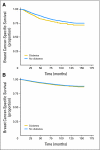Impact of diabetes mellitus on complications and outcomes of adjuvant chemotherapy in older patients with breast cancer
- PMID: 19307509
- PMCID: PMC2674004
- DOI: 10.1200/JCO.2008.17.5935
Impact of diabetes mellitus on complications and outcomes of adjuvant chemotherapy in older patients with breast cancer
Abstract
Purpose: To evaluate whether diabetes affects patterns of adjuvant chemotherapy use, toxic effects of chemotherapy, and breast cancer outcomes.
Patients and methods: By using the Surveillance, Epidemiology, and End Results-Medicare database, we identified patients aged 66 years or older who had stages I through III breast cancer that was diagnosed between 1992 and 2002. Multivariable regression analyses were performed to determine the effect of diabetes on use of chemotherapy, toxicities, and outcomes. The risks of all-cause mortality and breast cancer-specific (BCS) mortality were estimated with the Kaplan-Meier method.
Results: Our cohort had 70,781 men and women, of whom 14,414 (20.36%) had diabetes. Among people who received chemotherapy (n = 11,826), 21.0% were diabetics. In this group, diabetics had lower odds of receiving anthracyclines (odds ratio [OR], 0.78; 95% CI, 0.71 to 0.87) and taxanes (OR, 0.86; 95% CI, 0.75 to 0.99). Diabetes was associated with increased odds of being hospitalized for any chemotherapy toxicity (OR, 1.38; 95% CI, 1.23 to 1.56), for infection or fever (OR, 1.43; 95% CI, 1.2 to 1.7), for neutropenia (OR, 1.22; 95% CI, 1.03 to 1.45), for anemia (OR, 1.24; 95% CI, 1.05 to 1.47), and for any cause (OR, 1.32; 95% CI, 1.19 to 1.46). Patients with diabetes had higher all-cause mortality (hazard ratio [HR], 1.35; 95% CI, 1.31 to 1.39). There was a significant interaction between diabetes and chemotherapy use for BCS mortality. Diabetic and nondiabetic patients who did not receive chemotherapy had similar BCS mortality, but diabetic patients who did receive chemotherapy had higher BCS mortality than nondiabetic patients (OR, 1.20; 95% CI, 1.07 to 1.35).
Conclusion: In this observational, hypothesis-generating study, patients who have breast cancer and diabetes are at increased risk of chemotherapy-related toxicities compared with nondiabetic patients who are receiving chemotherapy and have higher all-cause mortality.
Conflict of interest statement
Authors' disclosures of potential conflicts of interest and author contributions are found at the end of this article.
Figures


References
-
- Wolf I, Sadetzki S, Catane R, et al. Diabetes mellitus and breast cancer. Lancet Oncol. 2005;6:103–111. - PubMed
-
- Engel J, Kerr J, Schlesinger-Raab A, et al. Quality of life following breast-conserving therapy or mastectomy: Results of a 5-year prospective study. Breast J. 2004;10:223–231. - PubMed
-
- Witt A, Yavuz D, Walchetseder C, et al. Preoperative core needle biopsy as an independent risk factor for wound infection after breast surgery. Obstet Gynecol. 2003;101:745–750. - PubMed
-
- Fleming ST, Rastogi A, Dmitrienko A, et al. A comprehensive prognostic index to predict survival based on multiple comorbidities: A focus on breast cancer. Med Care. 1999;37:601–614. - PubMed
-
- Yancik R, Wesley MN, Ries LA, et al. Effect of age and comorbidity in postmenopausal breast cancer patients aged 55 years and older. JAMA. 2001;285:885–892. - PubMed
Publication types
MeSH terms
Grants and funding
LinkOut - more resources
Full Text Sources
Other Literature Sources
Medical

